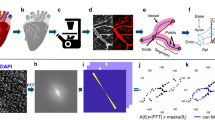Abstract
The corrosion cast method for scanning electron microscopy, transmission electron microscopy and auto-injection of tracers for light microscopy were used to examine the cardiac coronary development and the forming of the ventricular compact wall to the embryonal sponge-work wall. Our observations suggest that the coronary artery first extends over outer layer, and later over middle and inner layers. As intertrabecular spaces are closed by fusion to each endocardium in the inner layer position, the veins are formed by the remaining expanded sinusoidal intertrabecular spaces. The capillaries of the coronary vessels are then connected to the veins to finally complete the cardiac vascular system.
Similar content being viewed by others
References
Coffin, J.D. andPoole, T.J.: Embryonic vascular development: immunohistochemical identification of the origin and subsequent morphogenesis of the major vessel primordia in quail embryos.Development,102, 735–748 (1988).
Coffin, J.D. andPoole, T.J. Endothelial cell origin and migration in embryonic heart and cranical blood vessel development.Anat. Rec. 231, 383–395 (1991).
Patten, B.M.: The development of the ventricular wall and its blood supply.In: Cardiac Development with Special Reference to Congenital Heart Disease (Jaffee, O.C. ed.), Proceedings of the 1968 Int. Symp., University of Dayton Press, Dayton, Ohio, 1970.
Grant, R.T. andRegnier, M.: The comparative anatomy of the cardiac coronary.Heart,12, 285–317 (1926).
Grant, R.T.: Development of the cardiac coronary vessels in the rabbit.Heart,13, 261–271 (1926).
Conte, G. andPellegrini, A.: On the development of the coronary arteries in human embryos, stage 14–19Anat. Embryol. 169, 209–218 (1984).
Kondo, S., Suzuki, R., Yamazaki, K. andAihara, K.: Application of corrosion cast method for scanning electron microscopic observation of mouse embryo vasculature.J. Electron Microsc. 42, 14–23 (1993).
Mori, K.: Identification of lymphatic vessels after intraarterial injection of dye and other substances.Microvasc. Res. 1, 268–274 (1969).
Sato, S., Ashraf, M., Millard, R.W., Fujiwara, H. andSchwartz, A.: Connective tissue changes in early ischemia of porcine myocardium: an ultrastructural study.J. Mol. Cell. Cardiol. 15, 261–275 (1983).
Viragh, S. andChallice, C.E.: The origin of the epicardium and the embryonic myocardial circulation in mouse.Anat. Rec. 201, 157–168 (1981).
Rychter, Z. andOstadal, B.: Fate of “sinusoidal” intertrabecular spaces of the cardiac wall after development of the coronary vascular bed in chick embryo.Folia Morphol. 19, 31–44 (1971).
Author information
Authors and Affiliations
Rights and permissions
About this article
Cite this article
Sato, S., Kondo, S. & Aihara, K. Formation of the cardiac vascular system and ventricular compact wall. Med Electron Microsc 28, 137–145 (1995). https://doi.org/10.1007/BF02347956
Received:
Accepted:
Issue Date:
DOI: https://doi.org/10.1007/BF02347956




